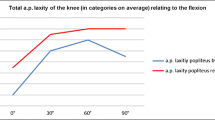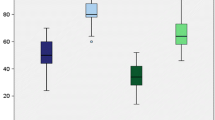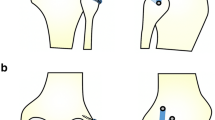Abstract
Purpose
The purpose of this study was to evaluate the clinical outcomes of patients who were treated with an arthroscopic popliteus bypass (PB) technique, in cases of a posterolateral rotational instability (PLRI) and a concomitant posterior cruciate ligament (PCL) injury of the knee.
Methods
This was a retrospective case series in which 23 patients were clinically evaluated after a minimum of 2 years following arthroscopic PB and combined PCL reconstruction. Lysholm, Tegner and Knee Injury and Osteoarthritis Outcome scores as well as visual analog scales (VAS) for joint function and pain were evaluated. Posterior laxity was objectified with stress radiography and a Rolimeter examination. Rotational instability was graded with the dial test.
Results
23 patients were available for follow-up, 46.0 ± 13.6 months after surgery. The median time interval from the initial injury to the surgery was 6.0 (3.5;10.5) months. The postoperative Lysholm Score was 95.0 (49–100); the Tegner Score changed from 6.0 (3–10) before the injury to 5.0 (0–10) at the follow-up examination (p = 0.013). The side-to-side difference on stress radiography (SSD) of posterior translation changed from 10.4 (6.6–14.8) mm before the injury to 4.0 (0.2–5.7) mm postoperatively (p < 0.01). Rotational instability was reduced to grade A (82.6%) or B (17.4%) (IKDC). The Rolimeter SSD was 2.0 (0–3) mm at the follow-up examination. VAS Function 0 (0–5), VAS pain 0 (0–6).
Conclusions
The arthroscopic PB graft technique provided good-to-excellent clinical results in the mid-term follow-up in patients with type A PLRI and concomitant PCL injury. However, an exact differentiation of lateral, rotational and dorsal instabilities of posterolateral corner (PLC) injuries is crucial, for the correct choice of therapy, as cases with lateral instabilities require more complex reconstruction techniques. Arthroscopic posterolateral corner reconstruction is a safe procedure with a high success rate in the mid-term follow-up.
Level of evidence
IV.




Similar content being viewed by others
Abbreviations
- IKDC:
-
International Knee Documentation Committee
- KOOS:
-
Knee Injury and Osteoarthritis Outcome Score
- LCL:
-
Lateral collateral ligament
- PB:
-
Popliteus bypass
- PCL:
-
Posterior cruciate ligament
- PLC:
-
Posterolateral corner
- PLRI:
-
Posterolateral rotational instability
- PTT:
-
Posterior tibial translation
- SD:
-
Standard deviation
- SSD:
-
Side-to-side difference
References
Chahla J, James EW, Cinque ME, LaPrade RF (2018) Midterm outcomes following anatomic-based popliteus tendon reconstructions. Knee Surg Sports Traumatol Arthrosc 26:812–818
Chahla J, Williams BT, LaPrade RF (2020) Editorial Commentary: Shedding Light on the Posterolateral Corner of the Knee: Can We Do it With the Scope? Is There a Real Benefit? Arthroscopy 36:1132–1134
Domnick C, Frosch KH, Raschke MJ, Vogel N, Schulze M, von Glahn M et al (2017) Kinematics of different components of the posterolateral corner of the knee in the lateral collateral ligament-intact state: A Human Cadaveric Study. Arthroscopy 10:1821–1830
Drenck TC, Preiss A, Domnick C, Herbort M, Frings J, Akoto R et al (2020) The Popliteus Bypass provides superior biomechanical properties compared to the Larson technique in the reconstruction of combined posterolateral corner and posterior cruciate ligament injury. Knee Surg Sports Traumatol Arthrosc 29:732–741
Fanelli GC (2020) PCL transtibial tunnel reconstruction. Sports Med Arthrosc Rev 28:8–13
Franciozi CE, Albertoni LJB, Kubota MS, Abdalla RJ, Luzo MVM, Cohen M et al (2019) A hamstring-based anatomic posterolateral knee reconstruction with autografts improves both radiographic instability and functional outcomes. Arthroscopy 35:1676–1685
Frings J, Kolb JP, Drenck TC, Krause M, Alm L, Akoto R et al (2019) Anatomic reconstruction of the posterolateral corner: an all-arthroscopic technique. Arthrosc Tech 8:153–161
Frosch KH, Akoto R, Drenck T, Heitmann M, Pahl C, Preiss A (2016) Arthroscopic popliteus bypass graft for posterolateral instabilities of the knee : A new surgical technique. Oper Orthop Traumatol 28:193–203
Frosch KH, Akoto R, Heitmann M, Enderle E, Giannakos A, Preiss A (2015) Arthroscopic reconstruction of the popliteus complex: accuracy and reproducibility of a new surgical technique. Knee Surg Sports Traumatol Arthrosc 23:3114–3120
Gelber PE, Drager J, Maheshwer B, Leyes M, Barenius B, Robinson J et al (2020) Large variability exists in the management of posterolateral corner injuries in the global surgical community. Knee Surg Sports Traumatol Arthrosc 7:2116–2123
Grimm NL, Levy BJ, Jimenez AE, Bell R, Arciero RA (2020) Open anatomic reconstruction of the posterolateral corner: the arciero technique. Arthrosc Tech 9:1409–1414
Hermanowicz K, Góralczyk A, Malinowski K, Jancewicz P (2018) Arthroscopic posterolateral corner stabilization with popliteus tenodesis. Arthrosc Tech 6:669–674
Hoher J, Akoto R, Helm P, Shafizadeh S, Bouillon B, Balke M (2015) Rolimeter measurements are suitable as substitutes to stress radiographs in the evaluation of posterior knee laxity. Knee Surg Sports Traumatol Arthrosc 23:1107–1112
James EW, Williams BT, LaPrade RF (2014) Stress radiography for the diagnosis of knee ligament injuries: a systematic review. Clin Orthop Relat Res 472:2644–2657
Kolb JP, Frings J, Krause M, Hartel M, Frosch KH (2019) An all-arthroscopic technique for complex posterolateral corner reconstruction. Arthrosc Tech 8:999–1006
LaPrade RF (2019) Editorial commentary: arthroscopic outcomes are equal to open popliteus tendon reconstructions, but do not forget that the goal is a stable posterior cruciate ligament reconstruction. Arthroscopy 35:2410–2411
LaPrade RF, Johansen S, Agel J, Risberg MA, Moksnes H, Engebretsen L (2010) Outcomes of an anatomic posterolateral knee reconstruction. J Bone Joint Surg Am 92:16–22
Lee D-Y, Park Y-J, Kim D-H, Kim H-J, Nam D-C, Park J-S et al (2018) The role of isolated posterior cruciate ligament reconstruction in knees with combined posterior cruciate ligament and posterolateral complex injury. Knee Surg Sports Traumatol Arthrosc 26:2669–2678
Li Y, Zhang H, Zhang J, Li X, Zheng T, Zhang Z et al (2019) The clinical outcome of arthroscopic versus open popliteal tendon reconstruction combined with posterior cruciate ligament reconstruction in patients with type a posterolateral rotational instability. Arthroscopy 35:2402–2409
Liu P, Gong X, Zhang J, Ao Y (2020) Anatomic, all-arthroscopic reconstruction of posterolateral corner of the knee: a cadaveric biomechanical study. Arthroscopy 36:1121–1131
Moulton SG, Geeslin AG, LaPrade RF (2016) A systematic review of the outcomes of posterolateral corner knee injuries, part 2: surgical treatment of chronic injuries. Am J Sports Med 44:1616–1623
Pache S, Aman ZS, Kennedy M, Nakama GY, Moatshe G, Ziegler C et al (2018) Posterior cruciate ligament: current concepts review. Arch Bone Joint Surg 6:8
Rios CG, Leger RR, Cote MP, Yang C, Arciero RA (2010) Posterolateral corner reconstruction of the knee: evaluation of a technique with clinical outcomes and stress radiography. Am J Sports Med 38:1564–1574
Schlumberger M, Schuster P, Eichinger M, Mayer P, Mayr R, Immendörfer M et al (2020) Posterior cruciate ligament lesions are mainly present as combined lesions even in sports injuries. Knee Surg Sports Traumatol Arthrosc 28:2091–2098
Song GY, Zhang H, Zhang J, Li Y, Feng H (2015) Anatomical popliteofibular ligament reconstruction of the knee joints: an all-arthroscopic technique. Knee Surg Sports Traumatol Arthrosc 23:2925–2929
Tisherman R, Wilson K, Horvath A, Byrne K, De Groot J, Musahl V (2019) Allograft for knee ligament surgery: an American perspective. Knee Surg Sports Traumatol Arthrosc 27:1882–1890
Treme G, Ortiz G, Gill GK, Menzer HM, Johnson PJ, Salas C et al (2017) A biomechanical comparison of knee stability after posterolateral corner reconstruction: Arciero vs LaPrade. Orthop J Sports Med. https://doi.org/10.1177/2325967117S00267
Weiler A, Frosch K-H, Gwinner C, Strobel MJ, Lobenhoffer P (2020) The posterolateral Instability score (PoLIS) of the knee joint: a guideline for standardized documentation, classification, and surgical decision-making. Knee Surg Sports Traumatol Arthrosc. https://doi.org/10.1007/s00167-020-06044-y
Weiss S, Krause M, Frosch KH (2020) Posterolateral corner of the knee: a systematic literature review of current concepts of arthroscopic reconstruction. Arch Orthop Trauma Surg 140:2003–2012
Winkler PW, Zsidai B, Wagala NN, Hughes JD, Horvath A, Senorski EH et al (2021) Evolving evidence in the treatment of primary and recurrent posterior cruciate ligament injuries, part 1: anatomy, biomechanics and diagnostics. Knee Surg Sports Traumatol Arthrosc 29:672–681
Acknowledgements
T.C.D. was supported by a research fellowship from Asklepios Clinic Group. The study was supported by albrecht© (Bernau, Germany). K.-H.F. received grants and is member of the Arthrex Advisory Board.
Funding
The study was supported by Albrecht® (Bernau, Germany).
Author information
Authors and Affiliations
Corresponding author
Ethics declarations
Ethical approval
IRB approval was given by the ethics committee of the Medical Chamber Hamburg, Germany (ID PV 7068).
Conflict of interest
T.C.D. was supported by a research fellowship from Asklepios Clinic Group. K.-H.F. received grants and is member of the Arthrex Advisory Board. The other authors declare to have no conflict of interest.
Additional information
Publisher's Note
Springer Nature remains neutral with regard to jurisdictional claims in published maps and institutional affiliations.
Rights and permissions
About this article
Cite this article
Drenck, T.C., Frings, J., Preiss, A. et al. The treatment of posterolateral knee instability with combined arthroscopic popliteus bypass and PCL reconstruction provides good-to-excellent clinical results in the mid-term follow-up . Knee Surg Sports Traumatol Arthrosc 30, 1414–1422 (2022). https://doi.org/10.1007/s00167-021-06590-z
Received:
Accepted:
Published:
Issue Date:
DOI: https://doi.org/10.1007/s00167-021-06590-z




